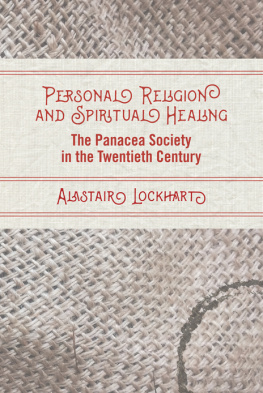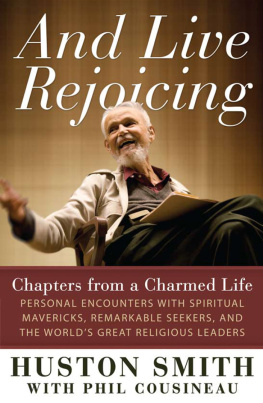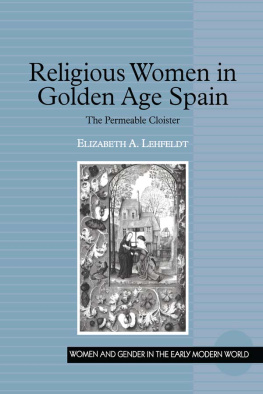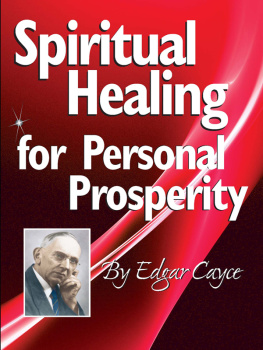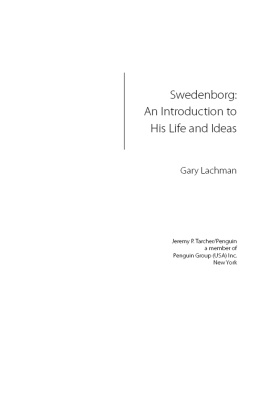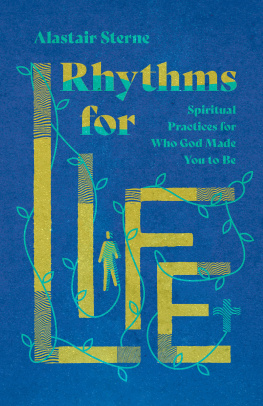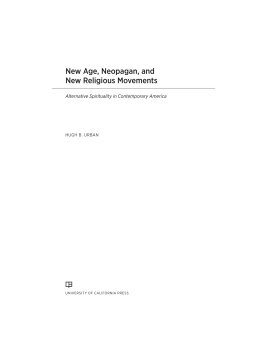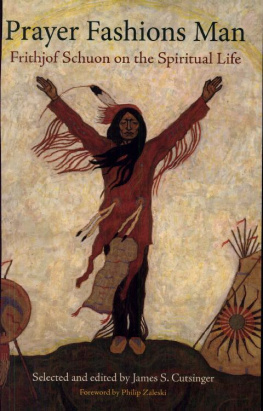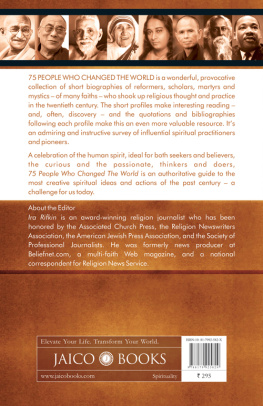P ERSONAL R ELIGION AND S PIRITUAL H EALING
SUNY series in Western Esoteric Traditions
David Appelbaum, editor
P ERSONAL R ELIGION
AND S PIRITUAL H EALING
The Panacea Society
in the Twentieth Century
A LASTAIR L OCKHART
Cover art: Leonora Simpson, Weave VII, photographic image of linen with water stain.
Published by State University of New York Press, Albany
2019 Alastair Lockhart
All rights reserved
Printed in the United States of America
No part of this book may be used or reproduced in any manner whatsoever without written permission. No part of this book may be stored in a retrieval system or transmitted in any form or by any means including electronic, electrostatic, magnetic tape, mechanical, photocopying, recording, or otherwise without the prior permission in writing of the publisher.
For information, contact State University of New York Press, Albany, NY
www.sunypress.edu
Library of Congress Cataloging-in-Publication Data
Names: Lockhart, Alastair, author.
Title: Personal religion and spiritual healing : the Panacea Society in the twentieth century / Alastair Lockhart.
Description: Albany : State University of New York, 2019. | Series: SUNY series in western esoteric traditions | Includes bibliographical references and index.
Identifiers: LCCN 2018012737| ISBN 9781438472850 (hardcover : alk. paper) | ISBN 9781438472874 (e-book)
Subjects: LCSH: Bedford (England) Church history 20th century. | Panacea Society. | Women and religion England Bedford History 20th century. | Christian communities England Bedford History 20th century.
Classification: LCC BR763.B38 L63 2019 | DDC 267/.43 dc23 LC record available at https://lccn.loc.gov/2018012737
10 9 8 7 6 5 4 3 2 1
To the memory of
RUTH KLEIN (19322012)
The last Panacean
CONTENTS
ILLUSTRATIONS
ACKNOWLEDGMENTS
The funding for this research was provided by the Panacea Charitable Trust. I am incredibly grateful to the Trust for its support and generosity in providing access to its unique archive. As a postdoctoral researcher in the Faculty of Divinity at the University of Cambridge in 2010, I had the good fortune to be included as a member of a project entitled Spiritual Healing in Modern Context, led by Dr. Fraser Watts. The Modern Context Project was designed to examine the Panacea Societys archive of twentieth-century documents related to its healing and to develop our understanding of the nature of modern religion using the sources available there. I had the privilege then of spending several years studying the Societys healing lettersmany of which were seeing the light of day for the first time since they had been neatly packed away nearly a hundred years earlier. Dr. Watts had been my Ph.D. supervisor at Cambridge, and, as a member of his team on the Modern Context Project, I continued to have the benefit of his enormous experience and insight. Many others contributed to the project as it progressed. I would like to record my gratitude to Samuli Siikavirta and Anna Porko, who provided working translations of a number of passages of Finnish prose on which my English quotations are based; to Kelly Stock and Nicola Swinburn for their assistance in the archive; and to Hazel Bird at Wordstich Editorial for her help proofing the manuscript.
A book of this nature depends to a very large extent on the archival sources on which it is able to draw. In having access to the Panacea Societys archives, I have been able to work from a remarkable and unique collection of materials. The credit for uncovering the Panacea Societys archive and making it available to academic study goes to Dr. Jane Shaw at the University of Oxford. Following her discovery of the archive in 2001, Dr. Shaw convened the Oxford Prophecy Project with Professor Christopher Rowlandalso based at Oxfordin 2003. The Prophecy Project initiated the process of opening up the Panacea Society and its extraordinary archive. Thanks to the archival work of Dr. Philip LockleyGod: The Story of a Female Messiah and Her Followers (2011), which emerged from Dr. Shaws own work on the Society, the project that formed the basis of this book could build on a firm base in getting to grips with the archiveand with the Societys healing in particular. On a day-to-day basis, much of the Trusts activities are overseen by Mr. David McLynn. I am most grateful for his help and support as the project developed.
This book brings together a number of strands of research centered on the Panacea Society archives Healing Collection. Some elements have been previously presented, including in the following publications: Heterodox Healing and Alternative Religion in the 20th Century: An English Spiritual Healing Practice in Finland, published in the Yearbook of the Finnish Society of Church History for 2013 (Suomen kirkkohistoriallisen seuran vuosikirja 2013)especially for the discussion of Finland in .
In addition, I have presented elements of this research at several conferences, which have been helpful in testing and refining my approach to the project. I am grateful to have had the opportunity to present papers at the Healing and Curing Medieval to Modern conference at the University of Glasgow in August 2012; the Modern British History Society, Culture, Politics and Religion conference at the University of Edinburgh in June 2013; the Annual Meeting of the American Academy of Religion in November 2014 (two papers); and the International Network for the Study of War and Religion at the Modern World Annual Conference in July 2015.
Within the University of Cambridge, the Faculty of Divinity, Hughes Hall, and the University Librarynot to mention the multitude of smaller libraries in Cambridge and elsewherehave provided me with resources and contexts for an infinity of small and large interactions with students and academics across disciplines. These have been immensely valuable to me throughout this research, and I am most grateful to these institutions.
In the midst of years of research, my wife has been a constant source of support and encouragement. She holds all the important things together, and without her I doubt this book would have reached publication. Thank you, Emma.
Finally, the last member of the Societys religious membership, and the last overseer of the healing, Mrs. Ruth Klein, passed away in 2012 while this project was in process. While my presence in the archive must have represented something of an intrusion into her daily life, in her kindness and willingness to help me understand the archive she was unfailingly considerate. Her dignity, thoughtfulness, and sense of duty remain present to meit is only appropriate that this book is dedicated to her memory.
INTRODUCTION
The Panacea Society and the Study of Religion
In 1924, a group of women living as a religious community in the town of Bedford in the south of England began a public campaign to promote what they believed was a method of spiritual healing discovered under divine inspiration. For ninety years, the group, which called itself the Panacea Society, advertised its healing system and attracted inquiries and applications from all over the world. While the Society continues to exist as a secular institution with charitable and educational purposes (and the funding for the research on which this book is based was provided by that charity), the healing closed in 2012 when the last member of the Bedford leadership passed away. While the healing was available, nearly 130,000 people from more than one hundred countries submitted applications; all of those wrote to the Society at least once (when they applied), many wrote several times, and a few wrote a great many letters during their periods of contact. With a striking level of efficiency, the Societys workers in Bedford took great pains to catalogue the letters they received from the users of the healing, and for thousands of users the Society retained complete runs of original correspondence. As such, the Societys archives contain many thousands of letters on spiritual and religious matters, across nearly a hundred years of recent history, from people who are normally lost to the historical record. The purpose of this book is to present the outcome of a close study of the materials in that archiveto provide insight into the spiritual and metaphysical thinking of people whose ideas about such things are otherwise almost invisible in the historical study of religion.

